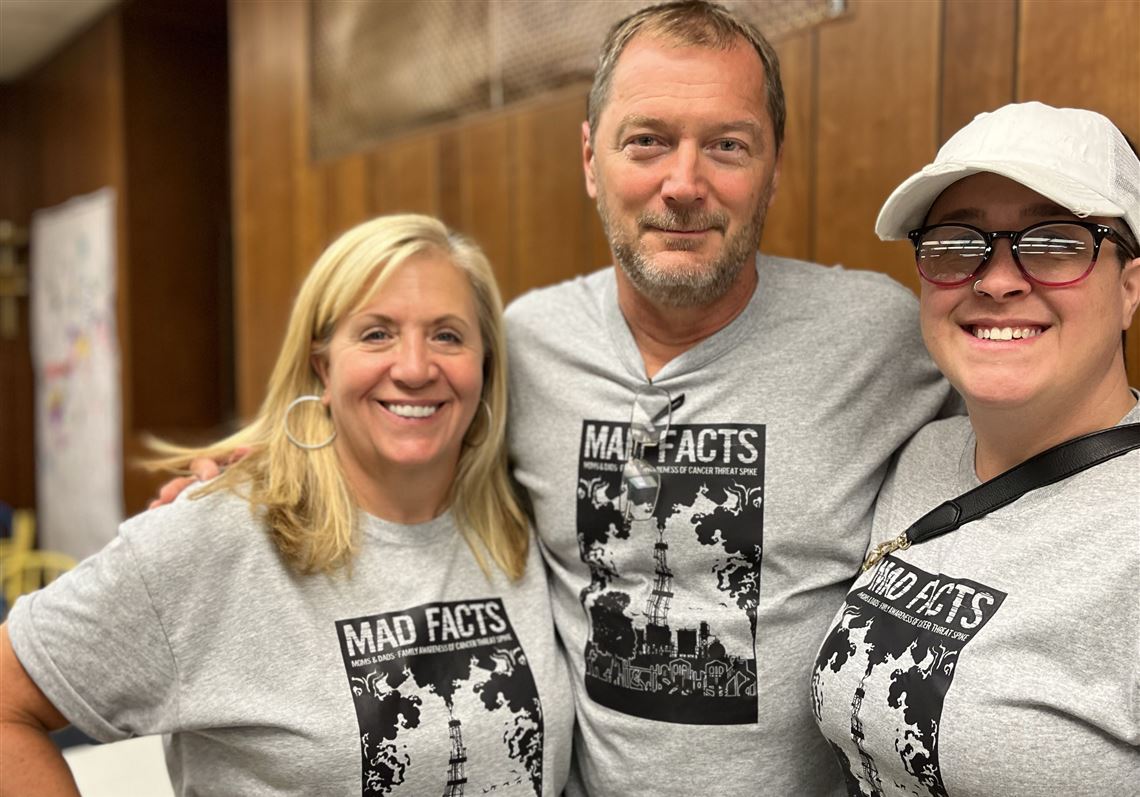In the kitchen of a Washington County church late Tuesday, Christine Barton recalled her son’s years with cancer.
Innocuous shoulder pain was the first sign. Mitchell Barton, 21 at the time, was an athlete and chalked up the distress to residual sports injuries over the years — perhaps a torn rotator cuff.
“As the months progressed, the pain became more frequent,” said Ms. Barton, of North Strabane. Then an ATV accident prompted him to see a chiropractor, who felt a lump in Mitch’s shoulder and encouraged him to see a doctor.
Months later, an oncologist delivered the results of scans: The baseball-sized tumor in his shoulder was either lymphoma or Ewing sarcoma.
“Do you know anything about either of those?” the doctor asked.
Mitch sat there with tears in his eyes, Ms. Barton remembered.
“Yes,” Mitch said. “My friend just died of Ewing sarcoma.”
That friend was Luke Blanock, from Cecil. Mitch and Luke played recreational baseball together; Mitch was the catcher, Luke the pitcher.
Luke was diagnosed with the rare bone cancer in 2013, when he was 16. Three years later, he was dead.
Luke’s parents, Janice and Kurt Blanock, and sister, Carla Marratto Cumming, sat with Ms. Barton Tuesday night at a table at California United Methodist Church, eating pizza and telling stories about their experiences with the cancer, which affects just 250 or so people in the U.S. every year and yet had touched these two Washington County families.
They were among about 30 dissecting what they had just heard during a presentation of studies that investigated proximity to oil and gas infrastructure and health. The community meeting, held at nearby California University of Pennsylvania, was long — about 150 minutes — and occasionally tense, as about 115 people struggled to balance the constraints of the scientific process with many lingering questions.
The three total studies, conducted by researchers at the University of Pittsburgh’s School of Public Health, looked at the risks of living within five miles of shale gas fracking sites and poor health, specifically some forms of pediatric cancer, poor birth outcomes and asthma, in children and adults. The years-long studies, commissioned by the state Department of Health, focused on eight southwestern Pennsylvania counties — Allegheny (outside of Pittsburgh), Armstrong, Beaver, Butler, Fayette, Greene, Washington and Westmoreland.
The researchers found moderate evidence for higher rates of lymphoma for those living near fracking sites, and limited evidence for central nervous system cancers, but they did not find a link to Ewing sarcoma nor conclusive evidence for higher rates of leukemia.
Results also showed those with asthma were four to five times more likely to have an attack if they lived near fracking wells during the production phase, which can last for decades. And babies whose moms lived near these sites were 20 to 40 grams lighter than average.
When the meeting was opened to questions, there were a lot of whys: Why didn’t you measure miscarriages? Why didn’t you measure radioactive exposure? Why didn’t you test the workers?
“I really feel as a community that we deserve better, and we deserve some more answers,” said Ms. Barton. “There has to be something going on here.”
When prompted by Ms. Marrato Cumming to take a tour of a fracking site to better embed themselves in the communities, DOH executive deputy secretary Kristen Rodack agreed on the spot to do so, along with her colleague, DOH director of epidemiology Sharon Watkins, and some Pitt researchers.
“We know these results do not alleviate pain and suffering,” Ms. Rodack said. “But we are committed to doing a better job to protect you.”
Some residents praised the more concrete findings, including the asthma results.
“Asthma is not a mild disease,” Ned Ketyer, president of Physicians for Social Responsibility of PA and a retired pediatrician, told the crowd. “It’s a serious disease. Very few people outgrow their asthma. People should be paying attention to that.” In an interview after the meeting, he called the asthma study “a bombshell.”
At the church after the presentation, the discussion turned to what the residents saw as research limitations, including a lack of environmental testing, such as water testing to look for any contaminants, and radiation exposure testing.
“When Mitch was diagnosed, I knew something was up,” said Ms. Blanock. “I thought, ‘This is not a coincidence.’” She recalled praying for another person with Ewing sarcoma, Kyle Deliere, who grew up in Cecil and was diagnosed in 2011. He died two years later, at age 27.
While the Pitt researchers did not find a link between Ewing sarcoma and living within five miles of a fracking site, they noted that the sample size was small, which could have impacted its statistical power.
“Being a scientist, we’re used to science always being an iterative process,” said Jim Fabisiak, director of the university’s Center of Healthy Environments and Communities and a co-investigator on the studies, during a later interview. “It makes slight increments over time. That increment leads to a question. The best science is the kind that leads to another question.”
That process, of course, takes time.
During the presentation, he gave an example regarding asthma and air quality. Theoretically, one could identify patients with asthma or asthma symptoms near fracking sites and follow them, giving each an air monitor and tracking fine particulate readings. But such a study would take years, undercutting activist arguments that more needs to be done sooner — not to mention the cost.
The studies used a retrospective model, which looks back in time at participants’ health instead of tracking patients in real time. Regarding radiation, there’s no precise way to measure exactly how much radiation each cancer patient was exposed to, which chemicals were involved and where they came from, said Mr. Fabisiak during the Q&A session.
The retrospective model and lack of environmental testing were sticking points for community members and industry officials alike. Community members wanted more information about potential exposure pathways that could have contributed to the observed rise in cancer and asthma.
Flaring or venting of gas, chemical runoff and contaminated waterways are all potential routes of exposure, with known carcinogens like benzene, a chemical involved in fracturing rock. While the study reported links between fracking sites and cancer, the lack of specific information about where the chemical exposure comes from left residents without detailed knowledge of how to protect their families.
“I understand that the community perspective is that the last thing we need is another study,” said Mr. Fabisiak. “But all we can do as scientists is provide information. It’s up to other people to take that information and implement it into policy in some way.”
That’s something Heaven Sensky called for at the church. Many there were wearing gray T-shirts promoting Mad Facts, a budding organization led by Ms. Blanock to raise awareness about the cancer incidences in Washington County and support affected families.
“What I want everybody to take away is that [the study] did find harm,” said Ms. Sensky, referencing the lymphoma and asthma results. “We can really take that data and do something with it. We’re not going to wait another five years. We’re going to take this to Harrisburg and present some real demands.”
Mad Facts — which stands for “Moms and dads: family awareness cancer threat spike” — plans to travel to the state capitol in the fall.
Jodi Borello, a member of the organization, said the demands will mostly match the eight recommendations made in a 2020 statewide report on the unconventional oil and gas industry, conducted by the 43rd Statewide Investigating Grand Jury. Those demands include requiring tighter regulations for the unconventional oil and gas industry and expanding no-drill zones from the current 500-foot buffer to 2,500 feet from a home or water well. Convened under then-Attorney General Josh Shapiro, who now is governor, the grand jury found government oversight of these industries to be weak.
Ms. Barton is looking forward to traveling to Harrisburg as a Mad Facts member, grateful that her son survived his cancer. After he was diagnosed in 2018, he received a year of chemotherapy and radiation; by January 2020, he was considered in remission from Ewing sarcoma. He is now married and has an electrical company in North Strabane.
Other research is occurring outside of the University of Pittsburgh that may be able to fill in gaps left from the Pitt studies’ methodologies. A team at Penn State University, including associate professor of geography Jenn Baka, is conducting a study that she suspects may address lingering questions residents have about health risks.
She sat with community members at the church, hoping to connect with those willing to let her team test their groundwater for contaminants.
The team aims to begin sampling 100 to 200 homeowners’ wells within the next year and examine whether they are over federal allowable limits for certain chemicals. The study is funded by HEI Energy, a nonprofit independent research organization.
“Ideally, I would love to give Janice an answer for why her son got Ewing sarcoma,” Ms. Baka said.
Hanna Webster: hwebster@post-gazette.com
First Published: August 19, 2023, 9:30 a.m.
Updated: August 19, 2023, 5:41 p.m.

















